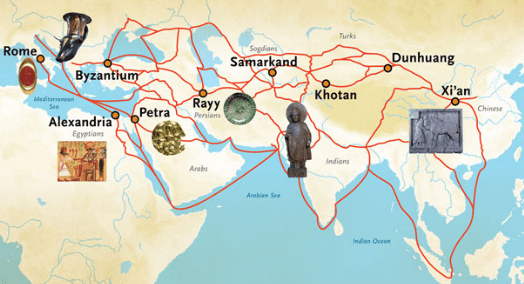By Islam Salah
Imagine a world without highways, planes, or ships—where goods and ideas traveled on the backs of camels along dusty trails carved through deserts and mountains.
This was the world of the ancient Middle East, home to some of history’s most iconic trade routes. These pathways shaped economies and connected cultures, leaving legacies that linger even in our modern age!
The Incense Trade Route: Fragrant Fortunes
Stretching across the Arabian Peninsula, the Incense Trade Route was the lifeline for frankincense and myrrh, two of the ancient world’s most prized commodities. Sourced primarily from southern Arabia (modern-day Oman and Yemen), these fragrant resins were in high demand for religious rituals, medicine, and perfumes.
The route connected these sources to bustling markets in the Levant, Egypt, and even Rome. Along its paths, cities flourished, like Petra in modern-day Jordan, which thrived as a key stop for traders.
King’s Highway: The Royal Road to Connection
The King’s Highway was a vital route of travel and trade. Spanning from Egypt through the Sinai Peninsula and Jordan to Damascus, it served as a bridge between Africa and the ancient empires of Mesopotamia.
Traders moved spices, textiles, and metals while armies marched and pilgrims journeyed along its path. Later, under Islamic rule, it became a critical route for Hajj pilgrims heading to Mecca.
Today, sections of the road are still in use in Jordan as Highway 15 and Highway 35, connecting Irbid in the north with Aqaba in the south.
Via Maris: The Way of the Sea
The Via Maris, or “Way of the Sea,” hugged the Mediterranean coastline, linking Egypt to Syria and Mesopotamia. This route was a bustling corridor of exchange, where goods like grains, olive oil, and luxury items flowed freely.
It also served as a conduit for ideas and cultural influences, shaping civilizations along its path. While its physical trails have faded, the connections it fostered laid the groundwork for future trade networks in the region.
Trans-Saharan Trade: Gold, Salt, and Stories
The Trans-Saharan Trade Route was an extraordinary feat of human resilience and ingenuity. It connected North Africa with sub-Saharan kingdoms, enabling the exchange of gold, salt, ivory, and even spices.
Caravans of thousands of camels braved the harsh desert conditions, creating links that fueled the prosperity of cities like Timbuktu and Gao. Though the route faded with the rise of sea trade, it laid the foundation for many trade routes that are still in use today.
Darb Zubaydah: Pilgrimage and Purpose
Named after the Abbasid queen Zubaydah bint Ja’far, this route was a lifeline for Muslim pilgrims traveling from Iraq to Mecca. More than just a road, Darb Zubaydah was an infrastructure marvel dotted with wells, reservoirs, and guesthouses to ease the pilgrims’ journey.
For centuries, it symbolized unity and devotion, serving millions of travelers. Today, its remnants stand as a testament to the enduring significance of faith and community in the Middle East.
A Legacy Etched in the Sands
Even though these ancient routes have long fallen out of use, their legacies are etched into the fabric of the Middle East. They laid the foundation for cultural exchanges, economic prosperity, and the spread of ideas. The cities they nurtured, the innovations they inspired, and the connections they forged continue to resonate to this day!
WE ALSO SAID: Don’t Miss…Retrace The Holy Family’s Route Across Egypt With The Manial Palace Museum’s Virtual Tour



